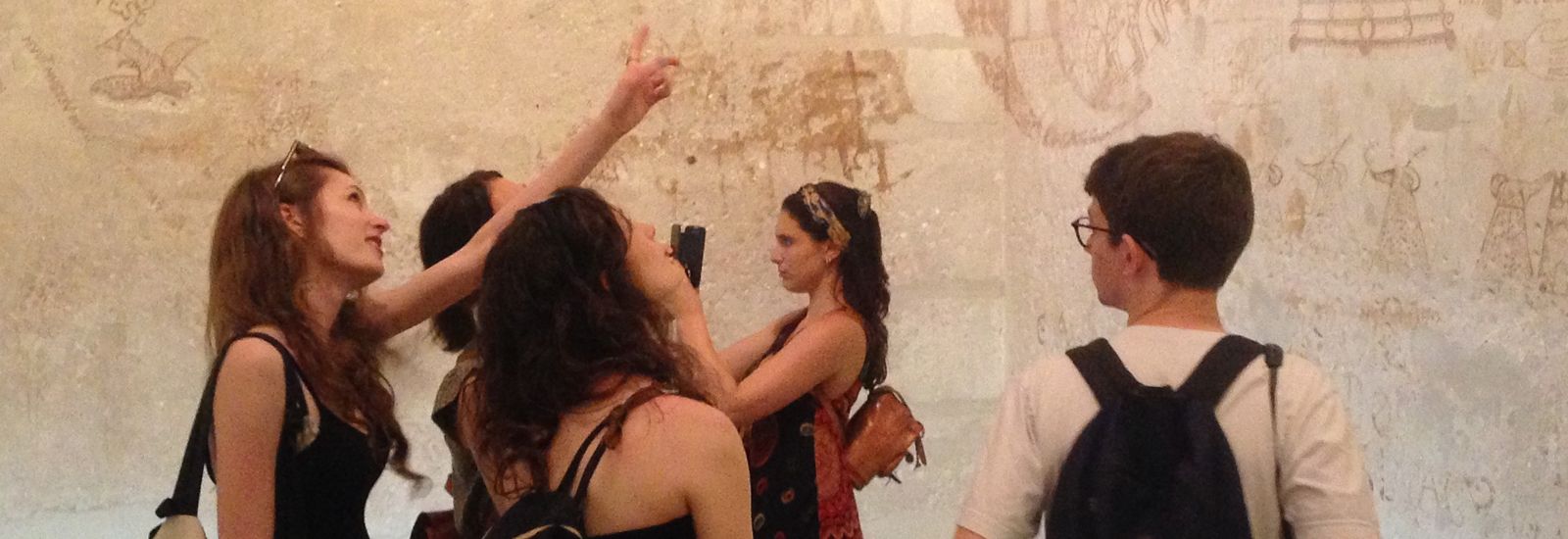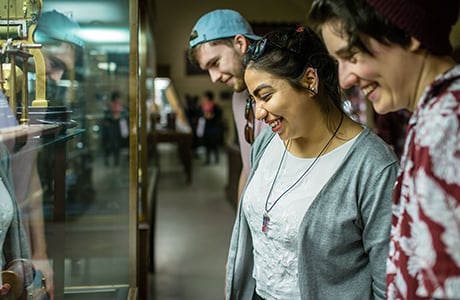
History of Art
Course overview
UCAS code: V350
Entrance requirements: AAA
Course duration: 3 years (BA)
Subject requirements
Required subjects: A subject involving essay writing
Recommended subjects: Not applicable
Helpful subjects: History of Art, Fine Art, History, English, a language
Other course requirements
Admissions tests: None
Written Work: One piece, one response
Admissions statistics*
Interviewed: 45%
Successful: 13%
Intake: 14
*3-year average 2022-24
Contact
Tel: +44 (0) 1865 286830
Email: [email protected]
Unistats information for this course can be found at the bottom of the page
Please note that there may be no data available if the number of course participants is very small.
About the course
Anything designed by human beings exhibits visual and material qualities that are specific to the place and period in which it originates.
History of Art aims to arrive at an historical understanding of the origins, meanings and purposes of art and artefacts from a wide range of world cultures. It asks about the circumstances of objects' making, their makers, the media used, their functions, their critical reception and their subsequent histories.
A degree in History of Art educates students in the historical interpretation of art in its cultural contexts. It also provides skills in the critical analysis of objects through the cultivation of visual literacy, as well as encourages students to analyse critically related texts and documents.
The acquired skills have broad applicability in a wide range of professional settings, as well as providing personal enlightenment and enjoyment.
The University's collections, including the famous Ashmolean and Pitt Rivers museums, provide objects for first-hand study under the supervision of those entrusted with their care. The historic architecture of the University, the city of Oxford and its environs supplies a rich source of study in its own right.
The Oxford degree is designed to provide innovative insights into a wide range of world art, drawing its expertise from various University faculties and the staff of University collections, as well as from the department itself.
There is a strong emphasis on how primary visual and written sources from various periods and places can be analysed in relation to works of art and architecture. Students are also encouraged to explore what it means to call something a work of 'Art' and to consider images and objects that may not necessarily conform to traditional definitions of 'Art'.
 |  | |
'My only knowledge of the subject before studying it at Oxford had come from my experience as a Fine Art student at A-level, my own reading, and from visiting exhibitions and galleries. I was thrilled to be able to continue my curiosities and further my knowledge in aspects of the course like the extended essay. To be able to do a serious, in-depth, and ultimately fascinating study of Walter Sickert and a collection of his drawings at the Ashmolean with some of the world’s experts on the subject was something I had wanted to do ever since I found out about the artist. Not only was I able to embark upon the project academically, but I also went on an ‘art-pilgrimage’ across northern France in search of the casino in which the works were made.' Arthur | 'I chose History of Art at Oxford because the course is unlike those taught at other institutions in that it provides not only a comprehensive understanding of the discipline, but is very self-reflective and questions the assumptions we hold when approaching "artworks" and what we include in that term. I feel that not only my knowledge has expanded, but I have been equipped with the skills and frameworks to interpret and understand artwork, not only as pieces within the canon, but rather as all visual culture that operates on so many dimensions, and in and out of many different contexts.' Shaun |
Unistats information
Discover Uni course data provides applicants with Unistats statistics about undergraduate life at Oxford for a particular undergraduate course.
Please select 'see course data' to view the full Unistats data for History of Art.
Please note that there may be no data available if the number of course participants is very small.
Visit the Studying at Oxford section of this page for a more general insight into what studying here is likely to be like.
History of Art
A typical week
Each week you will have around two lectures, and a weekly tutorial.
Teaching usually takes place in the department or in a college, as well as in one of the Oxford museums and galleries where tutors often lecture in front of actual works of art. Visits to exhibitions and historical buildings will also be part of the course.
Outside the classroom most of your time will be spent preparing essays for your tutorials and working in libraries, archives or museums on longer research papers.
Tutorials usually comprise between one and three students and a tutor. Class sizes may vary depending on the options you choose, but there would usually be no more than around 16 students, and often significantly fewer.
Most tutorials, classes, and lectures are delivered by tutors or curators. Many are world-leading experts with years of experience in teaching and research. Some teaching may also be delivered by postgraduate students who are studying at doctoral level and have normally received formal training in teaching undergraduates.
To find out more about how our teaching year is structured, visit our Academic Year page.
Course structure
Year 1
Courses | Assessment |
|---|---|
Four elements are taken:
Students also undertake a French, German or Italian for Art Historians course through the University’s Language Centre. No previous experience or qualifications are required for the language courses and they are not formally assessed. | First University examinations: three written papers and one extended essay |
Years 2 and 3
Courses | Assessment |
|---|---|
Seven elements are taken:
| Final University examinations: four or five written papers, one or two extended essay(s) and one thesis |
Visit the History of Art website for the latest information on all course details and a full list of current options.
The content and format of this course may change in some circumstances. Read further information about potential course changes.
Academic requirements
Qualification | Requirement |
|---|---|
A-levels: | AAA |
Advanced Highers: | AA/AAB |
International Baccalaureate (IB): | 38 (including core points) with 666 at HL |
Any other equivalent qualification: | View information on other UK qualifications, and international qualifications. |
Wherever possible, your grades are considered in the context in which they have been achieved.
Read further information on how we use contextual data.
Subject requirements
Essential: | Candidates are required to have taken an essay-based subject to A-level, Advanced Higher, Higher Level in the IB or any other equivalent. Read the advice on the History of Art website for further information about what are considered to be essay-based subjects. |
|---|---|
Helpful: | History of Art, Fine Art, History, English or a foreign language can be helpful to students in completing this course, although they are not required for admission. |
If a practical component forms part of any of your science A‐levels used to meet your offer, we expect you to pass it.
If English is not your first language you may also need to meet our English language requirements.
Applying
All candidates must follow the application procedure as shown on our Applying to Oxford pages.
The following information gives specific details for students applying for this course.
Written test
You do not need to take a written test as part of an application for this course.
Written work
Description: | Two pieces of written work: one marked essay of up to 2,000 words written for an A-level or equivalent course, which will demonstrate ability to construct a sustained written argument; one personal response, written in no more than 750 words, to a piece of art, architecture or design.* |
|---|---|
Deadline: | 10 November 2025 |
*Applicants should have first-hand access to their chosen object so that they may examine it closely in person. When submitting their response essay, they should include a photographic reproduction of their chosen object if possible. In writing their response, applicants may focus on whichever aspects of the object they consider to be most significant. These might include the medium, the design or style, the technique, the subject matter, and/or the location. No special preparation or research is required and footnotes / references are not expected unless a direct quotation is included. The 750-word response should demonstrate curiosity, sensitivity and clarity in response to the chosen object and visual culture more generally. It should be a new piece of writing, not previously submitted for another programme or for assessment or another school assignment.
Read our further guidance on the submission of written work for more information, and to download a cover sheet.
What are tutors looking for?
Candidates should show evidence of lively engagement with visual culture, both contemporary and historical. Prior knowledge of art history is absolutely not a requirement and many successful applicants have never studied the subject before university.
What is looked for in applicants is a keen and critical observation of art and of the visual and material environment in general. At interview, candidates are invited to demonstrate a willingness to engage in focused discussion and debate about visual issues, and in addition to responding to one or more photographs of unfamiliar images, which applicants will not be expected to recognise.
Visit the History of Art website for more information on the selection criteria for this course.
Careers
The cultural industries are one of the biggest employers in the world. In addition to museums, galleries and auction houses, there are many governmental and nongovernmental agencies that work to conserve, research and promote cultural heritage and to further the production of art both in the UK and around the world.
Furthermore, History of Art graduates will be especially competitive for posts in any area that requires combinations of visual and verbal skills. These include publishing, advertising, marketing, film, television and web-based media. History of Art also prepares graduates to enter the wide range of professions available to all humanities graduates, including the civil service, law and the financial sector.
We don't want anyone who has the academic ability to get a place to study here to be held back by their financial circumstances. To meet that aim, Oxford offers one of the most generous financial support packages available for UK students and this may be supplemented by support from your college.
Fees
Please note that for full-time Home undergraduate students, current university policy is to charge fees at the level of the cap set by the government, which for 2026/27 is £9,790. For details of annual increases, please see our guidance on likely increases to fees and charges. In the 2027/28 academic year course fees for Home fee status students will rise to £10,050 (in line with the government fee cap).
Fee status | Annual Course fees |
| Home | £9,790 |
| Overseas | £43,600 |
Further details about fee status eligibility can be found on the fee status webpage.
For more information please refer to our course fees page. Fees will usually increase annually. For details, please see our guidance on likely increases to fees and charges.
Living costs
Living costs at Oxford might be less than you’d expect, as our world-class resources and college provision can help keep costs down.
Living costs for the academic year starting in 2026 are estimated to be between £1,405 and £2,105 for each month you are in Oxford. Our academic year is made up of three eight-week terms, so you would not usually need to be in Oxford for much more than six months of the year but may wish to budget over a nine-month period to ensure you also have sufficient funds during the holidays to meet essential costs. For further details please visit our living costs webpage.
Financial support
Home | A tuition fee loan is available from the UK government to cover course fees in full for Home (UK, Irish nationals and other eligible students with UK citizens' rights - see below*) students undertaking their first undergraduate degree**, so you don’t need to pay your course fees up front. In 2026 Oxford is offering one of the most generous bursary packages of any UK university to Home students with a family income of around £50,000 or less, with additional opportunities available to UK students from households with incomes of £32,500 or less. The UK government also provides living costs support to Home students from the UK and those with settled status who meet the residence requirements. *For courses starting on or after 1 August 2021, the UK government has confirmed that EU, other EEA, and Swiss Nationals will be eligible for student finance from the UK government if they have UK citizens’ rights (i.e. if they have pre-settled or settled status, or if they are an Irish citizen covered by the Common Travel Area arrangement). The support you can access from the government will depend on your residency status. |
Islands | Islands students are entitled to different support to that of students from the rest of the UK. Please refer the links below for information on the support to you available from your funding agency: |
Overseas | Please refer to the "Other Scholarships" section of our Oxford Bursaries and Scholarships page. |
**If you have studied at undergraduate level before and completed your course, you will be classed as an Equivalent or Lower Qualification student (ELQ) and won’t be eligible to receive government or Oxford funding
Additional Fees and Charges Information for History of Art
There are no compulsory costs for this course beyond the fees shown above and your living costs.
Contextual information
Unistats course data from Discover Uni provides applicants with statistics about a particular undergraduate course at Oxford. For a more holistic insight into what studying here is likely to be like, please view the information below and explore our website more widely.
The Oxford tutorial
College tutorials are central to teaching at Oxford. Typically, they take place in your college and are led by your academic tutor(s) who teach as well as do their own research. Students will also receive teaching in a variety of other ways, depending on the course. This will include lectures and classes, and may include laboratory work and fieldwork. However, tutorials offer a level of personalised attention from academic experts unavailable at most universities.
During tutorials (normally lasting an hour), college subject tutors will give you and one or two tutorial partners feedback on prepared work and cover a topic in depth. The other student(s) in your tutorials will typically be doing the same course as you and covering the same topic. Such regular and rigorous academic discussion develops and facilitates learning in a way that isn’t possible through lectures alone. Tutorials also allow for close progress monitoring so tutors can quickly provide additional support if necessary.
Read more about tutorials and an Oxford education
College life
Our colleges are at the heart of Oxford’s reputation as one of the best universities in the world.
- At Oxford, everyone is a member of a college as well as their subject department(s) and the University. Students therefore have both the benefits of belonging to a large, renowned institution and to a small and friendly academic community. Each college or hall is made up of academic and support staff, and students. Colleges provide a safe, supportive environment leaving you free to focus on your studies, enjoy time with friends and make the most of the huge variety of opportunities.
- Each college has a unique character, but generally their facilities are similar. Each one, large or small, will have the following essential facilities:
- Porters’ lodge (a staffed entrance and reception)
- Dining hall
- Lending library (often open 24/7 in term time)
- Student accommodation
- Tutors’ teaching rooms
- Chapel and/or music rooms
- Laundry
- Green spaces
- Common room (known as the JCR).
- All first-year students are offered college accommodation either on the main site of their college or in a nearby college annexe. This means that your neighbours will also be ‘freshers’ and new to life at Oxford. This accommodation is guaranteed, so you don’t need to worry about finding somewhere to live after accepting a place here, all of this is organised for you before you arrive.
- All colleges offer at least one further year of accommodation and some offer it for the entire duration of your degree. You may choose to take up the option to live in your college for the whole of your time at Oxford, or you might decide to arrange your own accommodation after your first year – perhaps because you want to live with friends from other colleges.
- While college academic tutors primarily support your academic development, you can also ask their advice on other things. Lots of other college staff including welfare officers help students settle in and are available to offer guidance on practical or health matters. Current students also actively support students in earlier years, sometimes as part of a college ‘family’ or as peer supporters trained by the University’s Counselling Service.
Connect with us
Outreach programmes and events
Many academic departments and faculties at Oxford have dedicated outreach events and activities aimed at promoting their subject area(s) and supporting talented students from all backgrounds to apply to their courses.
University-wide events and resources
In addition to exploring department-run activities, we recommend checking out the outreach event calendar for upcoming University-wide events and other subject and college activities.
Subject-specific resources supporting supercurricular engagement for all ages can also be found via the University's Digital Resource Hub, suggested subject resources webpage and Oxplore, our online learning platform for 11-to-18-year-olds.
UK state school students interested in this or similar courses may like to explore UNIQ, Oxford's free flagship outreach programme for students in their first year of further education. UNIQ offers a choice of academic residentials in over 30 courses and each year provides around 1,500 students with the opportunity to experience Oxford's teaching, explore student life and receive expert support with their application to university.
Prospective applicants can sign up to receive step-by-step support with their Oxford application.
Read more about Oxford's widening access initiatives and other ways to connect with us before applying.

